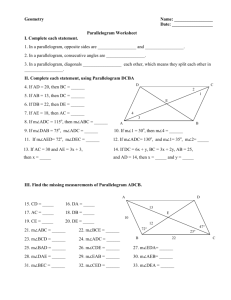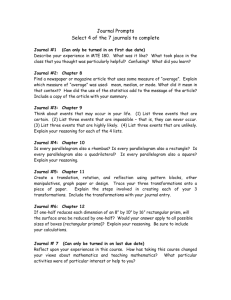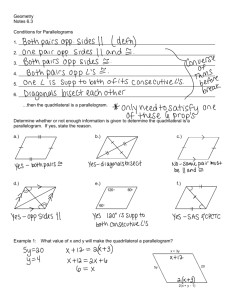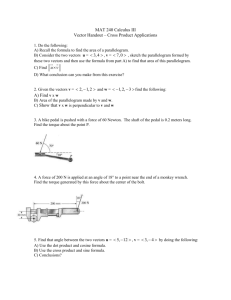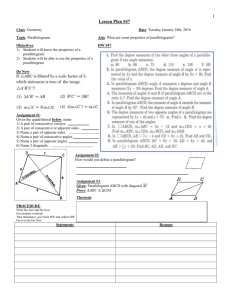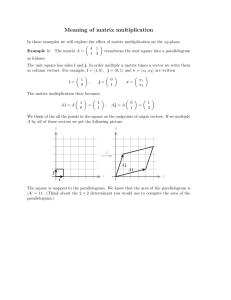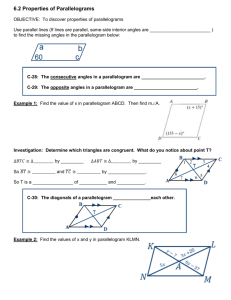Geometry Lesson Plan
advertisement
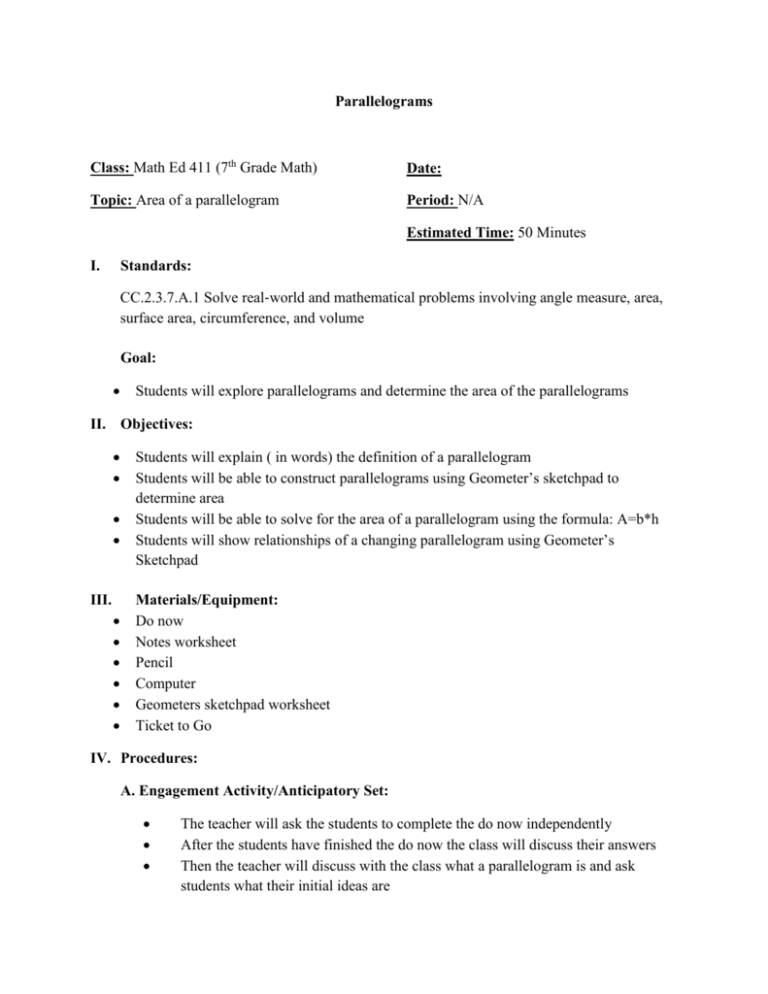
Parallelograms Class: Math Ed 411 (7th Grade Math) Date: Topic: Area of a parallelogram Period: N/A Estimated Time: 50 Minutes I. Standards: CC.2.3.7.A.1 Solve real‐world and mathematical problems involving angle measure, area, surface area, circumference, and volume Goal: Students will explore parallelograms and determine the area of the parallelograms II. Objectives: III. Students will explain ( in words) the definition of a parallelogram Students will be able to construct parallelograms using Geometer’s sketchpad to determine area Students will be able to solve for the area of a parallelogram using the formula: A=b*h Students will show relationships of a changing parallelogram using Geometer’s Sketchpad Materials/Equipment: Do now Notes worksheet Pencil Computer Geometers sketchpad worksheet Ticket to Go IV. Procedures: A. Engagement Activity/Anticipatory Set: The teacher will ask the students to complete the do now independently After the students have finished the do now the class will discuss their answers Then the teacher will discuss with the class what a parallelogram is and ask students what their initial ideas are Once the students have an idea of what a parallelogram the teacher will ask the students to break up and discuss using the idea of a rectangle to try and determine what the formula for area of a parallelogram is. The class will discuss after 5 minutes After the class goes over some examples the teacher will prompt the students to grab their assigned computers and start up Geometer’s Sketchpad The students will work on geometers sketchpad to complete their worksheet Students will learn what a parallelogram is, how to solve for the area, and what happens to the area when the parallelogram is enlarged or shrunk B. Body/Instructional Plan: After the students have completed the do now and discussed their findings, the teacher will then continue the lesson by asking students what a rectangle is, what a parallelogram is, and what the relationship between the two shapes are. The students will write their main ideas down on their worksheet and then the class will discuss (notes included) The teacher will then define what a rectangle and parallelogram are and how to solve for their areas. Do now used as an example. Then the teacher will turn the students loose to work with their shoulder partners on the problems on the rest of the problems on the parallelogram notes worksheet. Once the students have completed they will present their answers to the class. Once the students have had a chance to discuss the problems presented the students will then grab their assigned computers. They will start up Geometer’s Sketchpad as the teacher passes out the task they are to complete. They may work with each other but must complete their own worksheet. The teacher will walk around and answer questions when needed. After about 20 minutes the teacher will see how far the students progressed on their worksheet. If the majority of the class has completed the worksheet there will be a 5 minute warning to finish up any ideas. If the majority of the class is still working the students who have completed their worksheets will talk to a partner and compare their findings. After the students complete the worksheet the students will be asked to compare their answers with their shoulder partner. C. Closure and Extending Activities: After students have completed the worksheets the teacher will call on students to present their findings to the class. When students are sharing their responses the teacher will call on others to see if they had the exact same answers or if theirs were different and why that can happen. The teacher will go over the questions from the worksheet and discuss the students findings. If time allows the teacher will have students get out white boards to test the students on the formula of area of a parallelogram. Students worked with the computer to solve area, but now we need to test students’ knowledge on the formula. If time does not allow for this, the ticket to go tests them on the formula.( worksheet included) The teacher will distribute to the students a ticket to go which will test the students on the material they just learned. This will help me see if the students truly understood what a parallelogram is and how to find the area. V. Adaptations: Gifted students are encouraged to help other students when needed while working with geometers sketchpad VI. Evaluation of Students: Students will complete a do now at the beginning of class to test their prior knowledge Students will work individually or with a shoulder partner to complete the geometers sketchpad worksheet that will be collected The teacher will formally assess by having students answer reflection questions during their use with geometers sketchpad The teacher will informally assess by having the students use the white boards to solve problems about the area of a parallelogram The teacher will collect the Ticket to go to see what students understand about the day’s lesson. VII. Reflection References: http://faculty.kutztown.edu/schaeffe/GSP/Kerchner_GSP.pdf
